NC State grew the North Carolina sweet potato industry into a global powerhouse. (Courtesy: Bill Krueger / NC State University)
Can Sweet Potatoes Save the World?

Some foods are known as seasonal wonders, making an appearance only once or twice a year when families gather for holiday feasts. Cranberry sauce, pecan pie, eggnog. Sweet potatoes, typically with tiny marshmallows roasted on top, were once on that list. But sweet potatoes are on the rise.
They have become increasingly recognized as a superfood packed with essential vitamins and nutrients, and are now enjoyed throughout the year — in upscale restaurants, as a healthier alternative to French fries, and in products as varied as vodka, sausage and muffins.
Behind that rise is a remarkable success story with its roots at NC State, one that reaches into the familiar farms of eastern North Carolina and to the often forgotten corners of a handful of African nations. It is a story of science and salvation, of a pair of breeders who defied ridiculous odds to develop a new sweet potato variety that rescued the industry in North Carolina.
It is also a story that holds out promise for the future, well beyond the shores of North Carolina and its acres of sweet potatoes.
The work of a professor at NC State could transform the way sweet potatoes are eaten in several African countries, improving the health of young children and their mothers and creating new economic opportunities in Africa’s bustling cities and smallest villages.
Antonio Magnaghi is among those in Africa banking on sweet potatoes. He is well on his way to turning his small bakery on a crowded industrial street in downtown Nairobi, Kenya, into a thriving business that sells sweet potato muffins, fries and other products in the country’s top hotels, markets and coffee shops.
Antonio Magnaghi:
“The possibilities, they are endless with sweet potato.”
Counting on Covington
It was not that long ago, though, that the outlook for sweet potatoes was grim at best. Less than two decades ago, sweet potato farmers across eastern North Carolina were telling their kids to find another type of work because they couldn’t count on a decent crop of sweet potatoes.
They were primarily planting a variety known as Beauregard that was developed in Louisiana, and it was not well suited to North Carolina’s soil and climate.
There were too many unpleasant surprises — like getting your first look at a bad poker hand — when farmers dug up their sweet potatoes each fall. They kept finding odd shapes and sizes that wouldn’t sell in grocery stores.
Without a new variety, fewer and fewer sweet potatoes were going to be grown in North Carolina.
Jerome Vick, the patriarch of a large family farm in Wilson, North Carolina:
“Beauregard sweet potatoes were as ugly as homemade soap.”
“Our livelihood was at stake.”
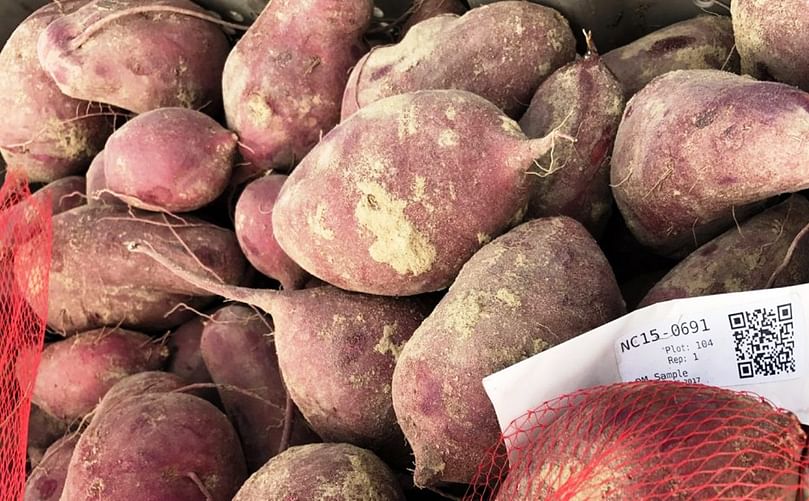
Despite the name, sweet potatoes are not potatoes. And a sweet potato is not the same thing as a yam. Sweet potatoes are native to Central and South America, while yams are a tuber native to Africa and Asia. (Courtesy: NC State University)
Year after year, from one field to another, it could be counted on to produce a high percentage of what are known as “number ones,” with the familiar shape, size and look to be sold in grocery stores and farmers’ markets.
By 2017, the amount of sweet potatoes grown in North Carolina had nearly doubled and the state had reclaimed its place as the leading producer of sweet potatoes in the United States.
Jim Jones, who grows about 1,500 acres of sweet potatoes in Nash County:
“Covington was the best thing that’s happened in the sweet potato business.”The combined efforts of NC State researchers, professors and extension agents, working closely with farmers and an engaged trade group, have transformed sweet potatoes into a year-round economic powerhouse that is now shipped from North Carolina to Europe and other corners of the globe.
Some farmers have described it as a perfect example of the work that a land-grant university such as NC State should do.
Pender Sharp ’71, a fifth-generation farmer in Sims, N.C., about an hour’s drive east of Raleigh:
“We just couldn’t operate without NC State.”But that’s only part of NC State’s sweet potato story.
Half a World Away
Craig Yencho is crouching in a field of sweet potatoes in the remote northwest corner of Uganda, not far from a massive tent camp that is home to thousands of refugees from South Sudan. He has driven more than seven hours from Kampala, the country’s chaotic capital city, across the Nile River and past a pack of wild baboons and a couple of wandering elephants to get to a research farm in the town of Arua.
He is struggling with a stick to dig into the dirt, which has been baked rock hard by the unforgiving equatorial sun and the delayed onset of the rainy season. What he finally pulls out of the ground is a scrawny excuse for a sweet potato. It is also riddled with holes that are signs of weevils, a small but pervasive pest that can wipe out a crop.
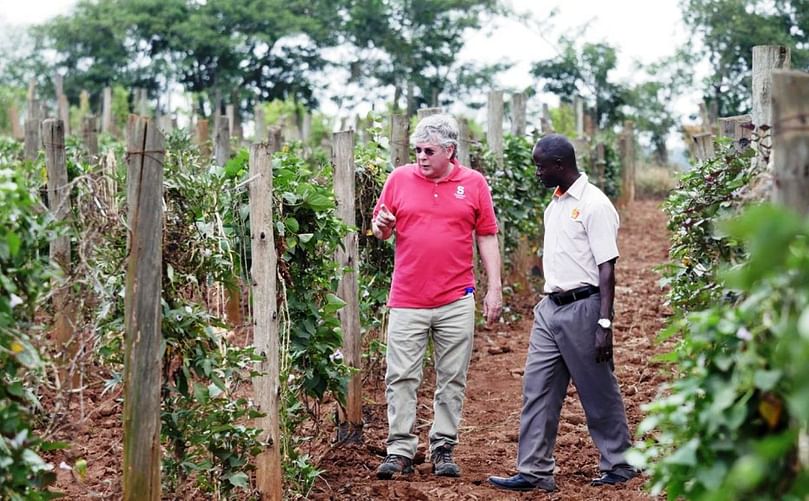
Craig Yencho and Bernard Yada ’14, Ph.D., survey sweet potato vines at a research farm outside Kampala, Uganda. (Courtesy: NC State University)
He also leads an effort, fueled by a $12 million grant from the Bill and Melinda Gates Foundation, to bring molecular science to sweet potato breeding programs in Uganda and a handful of other sub-Saharan countries in Africa.
His ultimate goal is twofold — to use sweet potatoes to increase economic opportunities and to get sweet potatoes’ nutrients into the bellies of children and pregnant women who suffer from such serious vitamin A deficiencies that they are in danger of going blind.
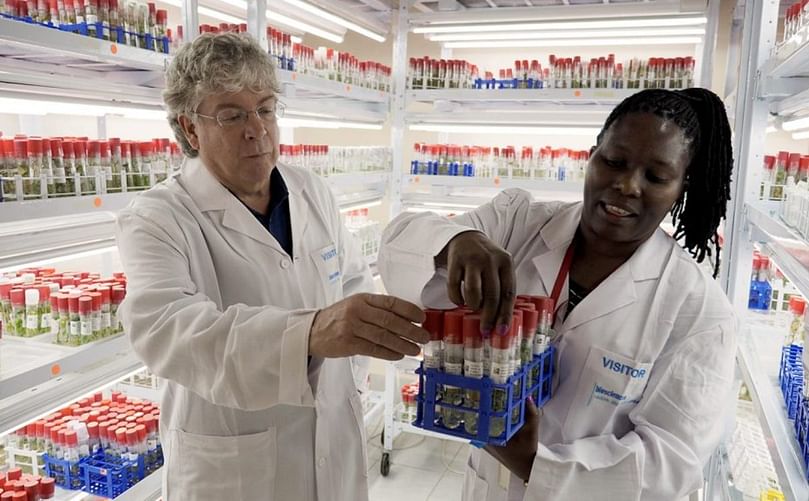
Yencho and Mercy Kitavi work with sweet potato samples in a lab in Nairobi, Kenya. (Courtesy: NC State University)
Instead of orange, they have white, cream-colored or yellow flesh, and are not as sweet or soft as their American cousins. They also don’t have all the nutrients found in orange-fleshed sweet potatoes.
But changing consumer preferences may be the easy part of Yencho’s challenge — early promotional efforts touting the health benefits of orange foods such as sweet potatoes and mangoes have created some converts.
Robert Mwanga ’01, Ph.D, a Ugandan scientist who won the World Food Prize in 2016 for his pioneering work to promote orange-fleshed sweet potatoes in his country:
“Kids are attracted by the orange color."The bigger challenge is breeding new varieties of orange-fleshed sweet potatoes that can be grown in Uganda. Weevils take advantage of dry, cracked soil brought on by drought (and a lack of irrigation) to burrow their way into growing sweet potatoes, and wipe out more than 70% of the crop in most years.
"Also, the softer the food is, the better it is for kids. It’s easier for them to eat.”
"Everywhere that sweet potato is grown [in Uganda], you will find weevils.”
“We still have a long way to go, to get something that farmers can leave out in the field and not worry about the weevil.”
As insurmountable as the challenges may seem, Yencho is undaunted. He laughs when he is asked during a visit to Uganda and Kenya last year if it feels like he is forever pushing a heavy rock up a steep hill, like a modern-day, gray-haired Sisyphus.
But Yencho prefers a different outlook, one that reflects an optimism dating back to his wanderlust days as a young Peace Corps volunteer in St. Kitts and Nevis.
Craig Yencho:
“Yeah, it can feel like that sometimes.”
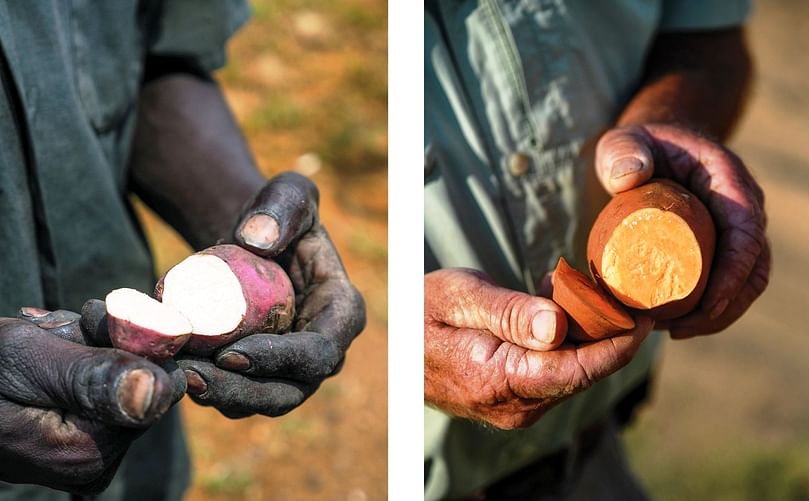
Malinga Emmanuel, a farmer in central Uganda, shows off a white-fleshed sweet potato grown and consumed throughout Uganda and other African countries.
While, in eastern North Carolina, Jim Jones holds a Covington orange-fleshed sweet potato, familiar to consumers throughout the United States.
(Courtesy: NC State University)
It takes into account the scientists he works with on a bucolic research campus in Nairobi, Kenya, to develop a program using advanced molecular breeding techniques that will help sweet potato farmers in Africa, North Carolina and elsewhere.
It takes into account home-grown entrepreneurial efforts he has seen in Africa that embrace the economic and health benefits that come with orange-fleshed sweet potatoes.
Yencho, during his visit to the farm in Arua, where researchers have been working with sweet potatoes for only three years, as he surveys the scene with Yada and a group of Ugandan breeders traveling with him and some of the farm staff:
“I like to think in terms of pebbles, ... and how a pebble tossed into a pond creates ripples.”He detects what he calls “drought damage,” but wonders about other damage to the crops.
“The field looks beautiful..."
“The rows are well laid out. Your weed management is really exceptional.”
“That’s goat damage,” someone tells him. “Say what?” Yencho asks. “Goat damage,” he is told again. Yencho laughs. “I’m an animal lover,” he says, “so that’s OK.”
It Takes Time
Ken Pecota is crouching in a field of sweet potatoes on a research farm in Clinton, N.C. A flap on his cap protects his neck from the sun as he works his way down dusty rows to check on several varieties being tested.
Pecota, a sweet potato researcher and breeder at NC State, was also one of the breeders behind Covington. It was clearly the signal achievement of his career, but he is determined to develop other varieties that will find their way into farmers’ fields.
Some are for niche markets, such as organics, while others are more suitable for processing into fries, chips or other uses. And there are no guarantees that problems won’t eventually develop with the Covington breed.

Ken Pecota shows off some of the sweet potato varieties being tested at a research farm in Clinton, N.C. (Courtesy: NC State University)
Ken Pecota notes some negatives and positive signs:
“If you’re ever satisfied as a breeder, you need to retire.”He slices into some of the sweet potatoes and takes a bite, and estimates the amount of starch (an important consideration for varieties bred primarily for processing into fries or chips). “I know that one’s got a medium starch,” he says at one point.
“There’s always something you can make better.”
“See, this guy rotted, that’s not a good sign.”
“They’ve got good uniformity, right? They’re all kind of the same shape. There’s a nice lightness, a really nice finish to it. The skin texture is beautiful.”
If you’re ever satisfied as a breeder, you need to retire. There’s always something you can make better.
Sweet potatoes have a much more complex genetic makeup than most vegetables, fruits and grains. Sweet potatoes are a hexaploid, which means they have six sets of chromosomes.
So it’s difficult to get the desired mix of traits. NC State’s breeders track 45 different traits — resistance to disease, drought tolerance, shape, color and size, to name just a few — in the sweet potato varieties they work with.
It takes years of trial and error to test new varieties, and the overwhelming majority end up having some sort of fatal flaw that makes them ill-suited for farming or processing. Yencho and his team start every year with 60,000 new varieties, knowing that most of them will fall short at some point during seven (or more) years of field tests.
At times, the process can seem downright cruel — a couple of years after releasing Covington, Yencho and Pecota released another variety named Hatteras that had performed well in all the field tests.
But after farmers started planting it, Hatteras developed something called internal necrosis, which creates brown flecks in the flesh. Within two years, no one was growing Hatteras. Pecota was once curious about just how difficult his job was, and calculated that there is as much as a one-in-two million chance of breeding a sweet potato that satisfies the criteria they try to meet.
Pecota is joking. As a kid in suburban New Jersey, he loved working on puzzles of all sorts — jigsaw, word, number — and he brings that same passion to his work as a breeder:
“If you look at that number, you’ll say, ‘That’s it, I quit.’.”
“That’s exactly what breeding is.”
“It’s a big puzzle.”
Life cycle of a sweet potato
- STARTING: Sweet potatoes are not started from seed. Instead, they are grown from vine cuttings that are called sprouts or slips. Some farmers start their sprouts in greenhouses, but others grow sprouts by “bedding” small sweet potatoes in March. Whole sweet potatoes are put on top of the ground and then covered with a thin layer of soil and plastic.
- TRANSPLANTING: Sprouts are cut and transplanted — either from a greenhouse or “bedding” field — to another field in May and June.
- GROWING: It takes 90–120 frost-free days to grow a sweet potato. They grow under the ground.
- HARVESTING: The harvesting of sweet potatoes typically starts in August. Tractors are used to flip them on top of the ground and then, because the thin skin can be easily scarred, they are harvested by hand. They are graded and sorted according to their size.
- CURING: Most sweet potatoes are cured for 4–7 days at 80–85 degrees so that they can then be stored for up to a year at 55 degrees with 85–90% humidity and adequate ventilation.
Efforts are further complicated by the sweet potato’s status as what is considered an “orphan crop.” Unlike crops like corn, wheat and rice, there have been no big corporations involved with sweet potatoes, which has historically been considered a subsistence crop for poor people.
That means no corporate dollars for research and technology, and it is why sweet potatoes lag behind other crops when it comes to the latest, molecular-based breeding programs.
Mercy Kitavi, a molecular breeder who works in Kenya with the program Yencho is leading:
“Sweet potatoes are under-researched.”
“When you look at the complex genetics of sweet potatoes, everybody is like, ‘Not me.’ We don’t know the answer to seemingly simple questions like the genetics of beta carotene.”
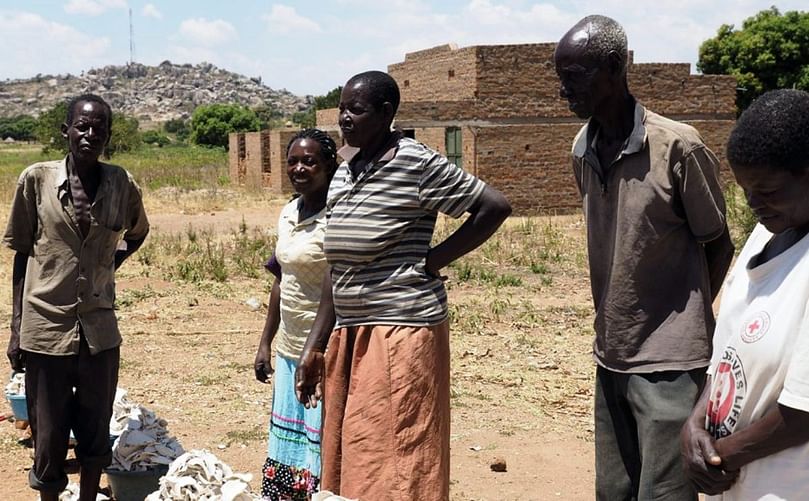
Along a highway in central Uganda, vendors sell slices of dried white-fleshed sweet potatoes. (Courtesy: NC State University)
It is all part of an effort to develop a set of genetic markers that could be used to bring more predictability to the process.
Such knowledge could be used, for example, to reduce the 60,000 new varieties that NC State’s program starts on the testing regimen each year to as few as 10,000–12,000. That’s less time and money spent on the front end, and a greater likelihood of positive results.
In part, that’s because there is not likely to be just one variety — like Covington in North Carolina — that will be the answer to the varying conditions throughout Africa.
Craig Yencho:
“We need to speed up variety development.”
“You have to breed African varieties in an African context.”
Cultural Differences
In Uganda, virtually everyone is a farmer. Dried sweet potatoes — none of them orange —are readily available from roadside vendors. Yencho’s team stops at one point on the highway from Soroti to Kampala to talk with a group of women selling buckets of dried sweet potato slices for 5,000 Ugandan shillings a bucket — that’s about $1.33.
The women, joined by their children and husbands, lead the visitors into their cluster of a half dozen huts to show off a large rock embedded in the ground — it is where they dry the sweet potatoes grown in a small plot nearby. (It is also, they say while pointing to an indention in the rock, a place where Jesus once stood.)
Mwanga, who led the early push for orange-fleshed sweet potatoes in his country, estimates that roughly 90% of households have their own farm, which may be no more than a half-acre. That’s 2 million households.
Compare that to North Carolina, where fewer than 400 farmers grow sweet potatoes, and most of them are part of a commodity group that works with the university and shares information. Extension agents spread throughout the state make it relatively easy to spread the word of new developments or problems for sweet potatoes.
In Uganda, there are more than 50 different languages spoken. That means there are more than 50 different ways to say sweet potato, from “acok” in Ateso, the language spoken by the people showing off their drying rock, to “maku” in Lugbara. Communication is difficult at best.
Bonny Oloka ’18, Ph.D., finished his graduate work with Yencho last year and returned to Uganda to work as a sweet potato breeder. He never ate orange-fleshed sweet potatoes growing up in Kampala, and says the challenge of replacing other sweet potatoes in his country is great.
Bonny Oloka:
“Every region you go to you will find completely different people.”
“The language is different, the cultures are different, the foods are different.”
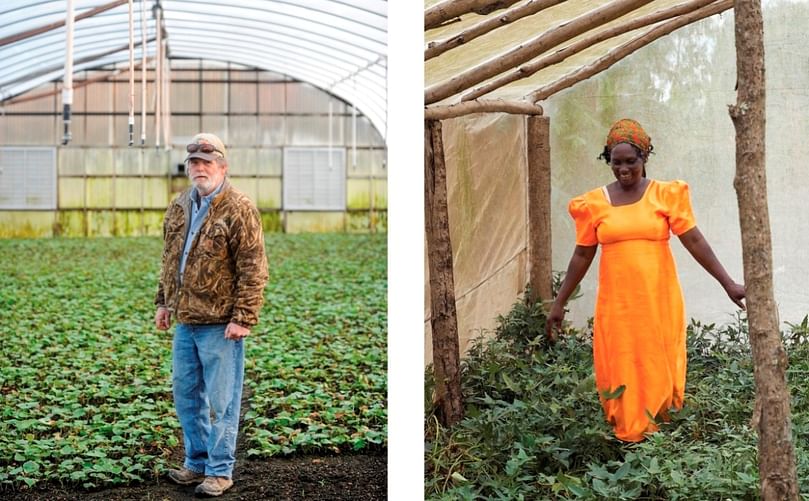
Jim Jones checks on one of several greenhouses he maintains at his farm in Bailey, N.C.
and Sekiyanja Joweria checks on the vines in the single greenhouse run by a sweet potato growers cooperative outside of Kampala, Uganda (Courtesy: NC State University)
“I think it’s attainable, because 15 years ago there was almost no orange-fleshed sweet potato in Uganda.”Likewise, Sadik Kassim, director of research at the government farm in Arua, says there is plenty of interest in orange-fleshed sweet potatoes in his region along the Nile River. He estimates that 15% of the households in the region — compared to 5% in the rest of the country — grow and eat orange-fleshed sweet potatoes:
“I didn’t have it. My parents could not get it. But now we know where to get it.”
“West Nile is where sweet potato can make a difference.”he implores Yencho during a meeting before heading out into the fields.
“Our market is there. Our problem is if we can produce a supply of good and clean vines [for growing sweet potatoes].”
Yencho appreciates the sentiment, but points out some of the region’s challenges, including a lack of irrigation and storage capacity for harvested sweet potatoes:
“his district has been ignored.”Sweet Success
While they are not as obvious as the success that farms in eastern North Carolina have had with sweet potatoes, encouraging signs can be found throughout Africa. Jan Low, an agricultural economist who has promoted the health benefits of orange-fleshed sweet potatoes throughout Africa, says Rwanda, Malawi and Mozambique have all seen an increase in the consumption of orange-fleshed sweet potatoes.
Jan Low, during a visit to the research campus in Nairobi:
“Those are all very important countries that have significant vitamin A deficiency problems.”One such success story can be found in downtown Nairobi, on the second floor of a nondescript building on a crowded street. Inside, Magnaghi is at work in his bakery, where he makes sweet potato muffins for some of the top hotels in the country, and is trying to develop sweet potato fries for Kenya’s largest chain of coffee shops.
Magnaghi describes himself as a “food application specialist,” but he is an entrepreneur at heart. He has worked in Italy, Australia and Rwanda, but was excited to return home to Kenya to explore the possibilities of sweet potatoes. He says that Kenyan consumers share his excitement, but that he struggles to get enough orange-fleshed sweet potatoes for his many projects.
Magnaghi:
“People are buying it because of the health reasons.”Yencho tells him that in North Carolina sweet potatoes are being used in beer and that sweet potato syrup is being used as a substitute for honey.
. “And then also because it’s a nice orange. It’s bright and it attracts a lot of people.”
"Oh, that I would like to visit."
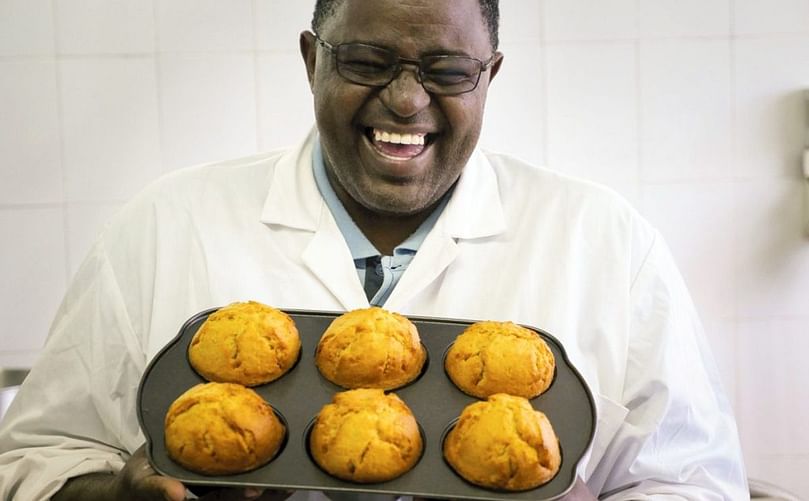
Antonio Magnaghi shows off a batch of sweet potato muffins at his bakery in downtown Nairobi, Kenya. (Courtesy: NC State University)
The office is a small, plain building with large metal doors and a handful of plastic chairs. Around the back is a single, makeshift greenhouse for growing sweet potato vines.
The cooperative, run by 100 women, sells orange-fleshed sweet potato vines to farmers and mills sweet potato flour that can be used to make pancakes, donuts and bread. Joweria does not speak English, so a translator helps as she shares her story.
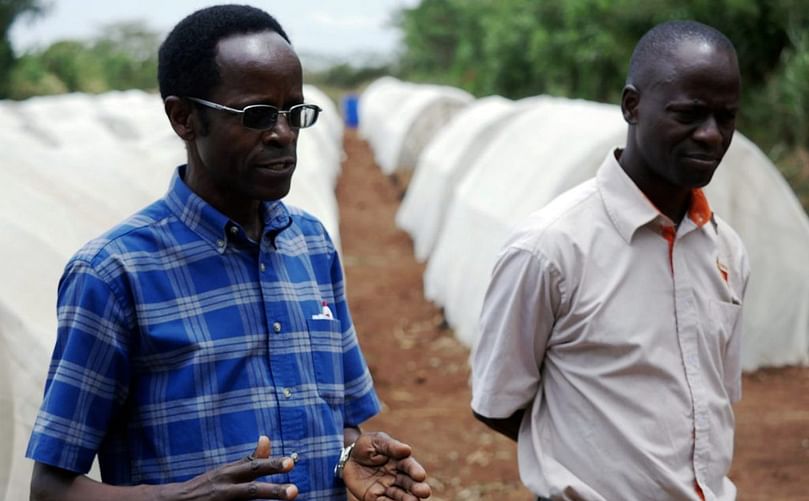
NC State graduate Robert Mwanga (left) on a research farm outside Kampala, Uganda. (Courtesy: NC State University)
Sekiyanja Joweria:
“We found a lasting solution.”
“We started seeing improvement.”
There is an entrepreneurial spirit … and a vibrancy that is beginning to emerge.
The cooperative has been a financial success, enabling the village to pay the school fees for 15 children to go off to college. Joweria’s son graduated with a degree in agriculture and her daughter is studying journalism.
While poverty is evident throughout Africa, Yencho says a closer look reveals opportunities such as those found in a small urban bakery or a rural Ugandan village.
Yencho:
“There is real significant poverty here.”Nothing Wasted
“But if you start to peel that away there is an entrepreneurial spirit. There is an emerging middle class and a vibrancy that is really beginning to emerge.”
For all of Covington’s success, there was never one moment when Yencho and Pecota felt it was appropriate to pop the champagne corks. They have a patent on Covington, which is described in the legal documents as an “invention,” and NC State licenses it to be grown in North Carolina and other parts of the country (and even a few other nations).
The licensing generates revenue that is used to cover the cost of the university’s breeding program. But in some ways Covington’s success just sort of happened, over time, until it simply became accepted that it was North Carolina’s sweet potato.

Linwood Vick ’96 checks on stacks of sweet potatoes at his family’s farm in Wilson, N.C. (Courtesy: NC State University)
About 85% of the sweet potatoes are sent to fresh markets, while the remaining 15% is sold to processors — a far cry from the days when some farmers dumped as much as 30% of their crop in the woods because the potatoes were too big or too small or otherwise unfit.
Dewey Scott,co-owner, told a group of researchers and breeders visiting last year from Africa, South America and elsewhere:
“Whatever is in that bin is used for something.”At Vick Family Farms, warehouses can store more than a half million bushels of sweet potatoes and about half of their sweet potatoes are exported to Europe, something that would have been unimaginable two decades ago.
Jerome Vick:
“All the stars lined up.”
“We have a good variety, good storage conditions, a year-round supply and we could go back after those markets we lost.”
It’s a better potato now.
Carolina Innovative Food Ingredients, a company in Nashville, N.C., makes sweet potato juice and dehydrated sweet potatoes that can be used in baked goods, beverages and sauces like ketchup and syrup.
The Sharps, who grow about 500 acres of sweet potatoes and raise hogs, had the help of NC State food scientists to develop a sausage infused with sweet potato juice, sweet potato puree and chunks of sweet potatoes. It is served, among other places, in Fountain Dining Hall at NC State.
Alan Sharp:
“It’s a better potato now.”Some even say sweet potatoes are trendy. Kelly McIver, executive director of the N.C. Sweet Potato Commission, notes that sweet potatoes are now found on the menus of high-end restaurants. One of the appetizers served at a wedding reception she attended last year combined sweet potatoes with goat cheese and a pimento.
“Twenty-five years ago, it wasn’t very good, it was dry and stringy.”
Kelly McIver:
“It’s a sexy food.”A sexy super food that can rescue a struggling industry and prevent blindness in remote areas of the world? That’s a lot to ask of a simple sweet potato. Even Yencho, ever the optimist, chuckles at the suggestion that the sweet potato could save the world.
But its reach is likely to grow, if only because consumers are more conscious about the health benefits of what they eat. Farmers in Uganda and other African countries are going to keep growing sweet potatoes, including those that are orange when you cut them open.
And Pecota is not going to stop working on new varieties anytime soon.The possibilities are endless. And that’s without any tiny, roasted marshmallows.
















